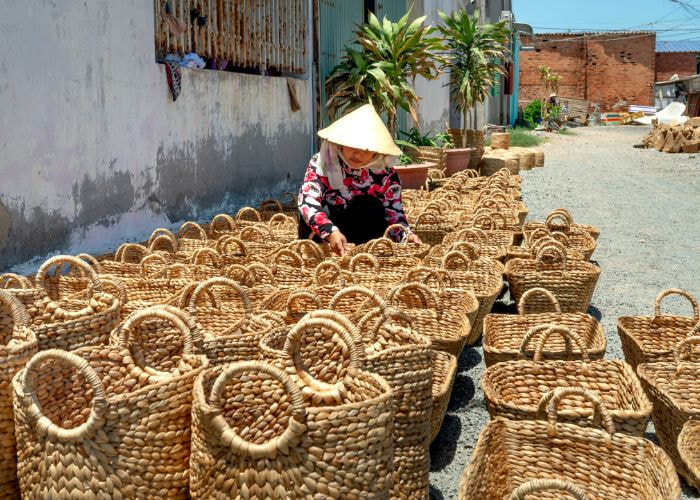-
09-07-2023, 11:20 AM #1
 Silver member
Silver member

- Ngày tham gia
- Jul 2023
- Bài viết
- 160
What is wicker furniture made of? Resin Wicker vs Wicker
Wicker refers to the technique of weaving materials like rattan, bamboo, reed, or synthetic fibers into a specific pattern to create items such as furniture, baskets, or decorative objects. It is a popular method used to make durable and visually appealing products.
The term "wicker" can refer to both the process of weaving and the finished product. Wicker furniture, for example, is made by weaving materials together to create frames, seats, and backs. The weaving technique involves intertwining strands of material in an over-and-under pattern or various intricate designs.

What is wicker furniture made of?
What is wicker furniture made of? Wicker furniture is typically made from natural or synthetic materials. Traditionally, natural wicker is made from plant materials like rattan, bamboo, or reed. These materials are woven together to create the furniture's structure and design.
However, synthetic wicker has become increasingly popular and is often made from materials such as resin or high-density polyethylene (HDPE). Synthetic wicker is designed to mimic the look and feel of natural wicker while being more durable and weather-resistant.
Here's a more detailed explanation of the materials used in both natural and synthetic wicker furniture:
Natural Wicker:- Rattan: Rattan is a vine-like plant that grows in tropical regions. It is a primary material used for making natural wicker furniture. The inner core of the rattan stalk is harvested, processed, and woven into furniture frames. It is known for its flexibility, strength, and durability.
- Bamboo: Bamboo is a fast-growing grass that is also used to make wicker furniture. It is lightweight, strong, and sustainable. Bamboo can be split into thin strips, which are then woven to create intricate patterns.
- Reed: Reed refers to various grass-like plants, such as seagrass or water hyacinth. These plants are harvested, dried, and woven to create furniture. Reed wicker furniture has a rustic and relaxed look.
Synthetic Wicker:- Resin: Synthetic resin wicker is made from materials like PVC (polyvinyl chloride) or PE (polyethylene). It is designed to mimic the appearance of natural wicker while being highly resistant to the elements. Resin wicker is durable, UV-resistant, and easy to clean. It often comes in various colors and textures.
- High-Density Polyethylene (HDPE): HDPE is a type of plastic widely used in synthetic wicker furniture. It is known for its strength, durability, and resistance to fading, cracking, and peeling. HDPE wicker is a popular choice for outdoor furniture as it can withstand exposure to sun, rain, and other harsh weather conditions.
Both natural and synthetic wicker furniture offer unique advantages. Natural wicker has a natural, organic look and feel, while synthetic wicker is more resilient and requires less maintenance. The choice depends on personal preference, desired style, and the intended use of the furniture.
Comparison: Resin Wicker vs Wicker
Here's a comparison table between Resin Wicker vs Wicker:
Resin Wicker Wicker
Material Synthetic resin materials (polyethylene) Natural materials (rattan, bamboo, cane, etc.)
Durability Highly durable and resistant to weather conditions Less durable and susceptible to damage from weather
Maintenance Low maintenance, easy to clean with soap and water Requires more maintenance, may need regular cleaning and occasional re-painting or re-sealing
Longevity Long-lasting, can withstand outdoor conditions for years Relatively shorter lifespan, may deteriorate faster when exposed to outdoor elements
Appearance Varied designs and colors, can mimic the look of natural materials Natural and rustic look
Flexibility Less flexible, tends to be stiffer and less pliable More flexible and can be easily shaped and woven into intricate patterns
Price Range Typically more expensive due to its durability and longevity Generally less expensive, but price can vary based on quality and material used
Indoor/Outdoor Use Suitable for both indoor and outdoor use Primarily intended for indoor use, outdoor use may require additional protection and maintenance
Please note that the specific characteristics and qualities may vary depending on the brand and quality of the wicker or resin wicker products.Chủ đề cùng chuyên mục:
- Creative Gift Basket Wrapping: Elegant Alternatives to Cellophane?
- Spark Imagination and Creativity with the Rattan Play Kitchen
- Small Rattan Coffee Table: Adding Rustic Charm to Your Living Space
- How to Make a Stunning Twig Star for Your Home Decor
- Top địa chỉ in tranh vân đá giá rẻ, đẹp tại TP.HCM
- Elevate Your Table Setting with Round Rattan Placemats
- DIY Guide: How to Make Willow Charcoal for Art and Crafting
- Indoor Oasis: Elevating Dining Spaces with Wicker Dining Room Chairs
- lắp đặt thiết bị điều khiển cổng tự động và thay thế phụ kiện hư hỏng
- Crafting Serenity: A Guide to Making Willow Dream Catchers
Có thể bạn quan tâm:
-
Wicker rattan pendant lampshade: Advantages and Uses
Bởi Thanhcongcraft trong diễn đàn Nội Ngoại ThấtTrả lời: 0Bài viết cuối: 09-05-2023, 03:10 PM -
Can you spray paint wicker furniture? How to spray paint wicker furniture?
Bởi Thanhcongcraft trong diễn đàn Nội Ngoại ThấtTrả lời: 0Bài viết cuối: 08-30-2023, 04:28 PM -
The Differences of Rattan and Bamboo Furniture
Bởi Thanhcongcraft trong diễn đàn Nội Ngoại ThấtTrả lời: 0Bài viết cuối: 08-16-2023, 03:12 PM



 Trả lời kèm Trích dẫn
Trả lời kèm Trích dẫn




Gel bôi trơn là một loại sản phẩm được dùng riêng cho hoạt động tình dục. Chất gel này có tác dụng bôi trơn, giảm ma sát của âm đạo với dương vật hoặc với các bộ phận khác trên thân. Nhờ có chất bôi...
Dầu bôi trơn dành cho đàn ông....